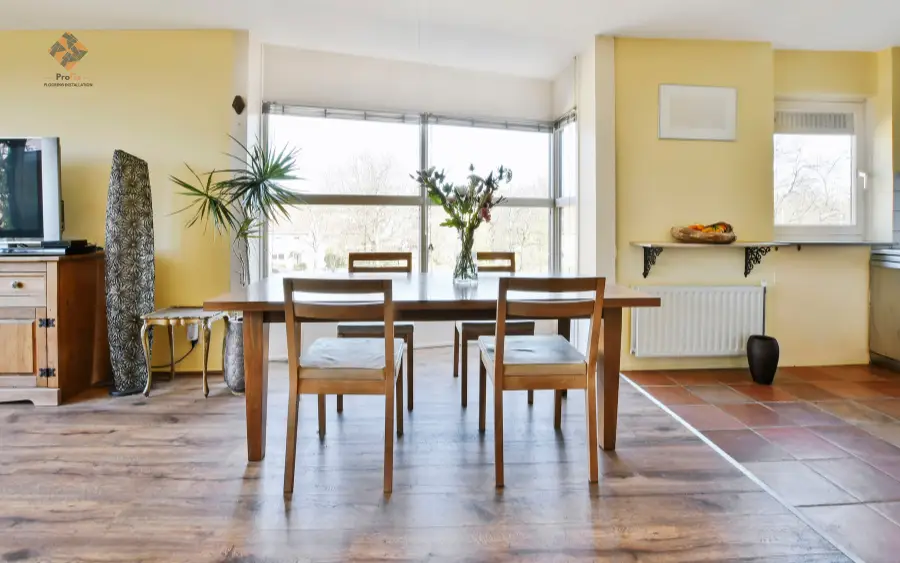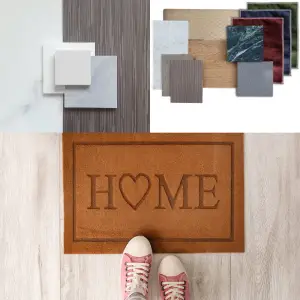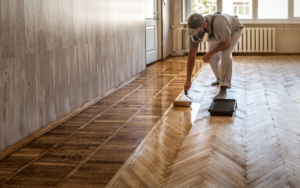Why Combine Different Types of Wood Flooring?
Creating a Customized Look
How mixed wood floors personalize your space
Combining different types of wood flooring allows homeowners to create a custom look tailored to their design preferences. Whether it’s mixing light and dark woods for contrast or using various textures, this approach helps create a unique and visually appealing space.
Making use of wood variations for room transitions
In open-concept spaces, mixing wood flooring types can be used to define specific areas. For instance, a transition from oak in the living room to walnut in the dining area creates a subtle distinction without the need for walls or rugs.
Benefits of Mixing Wood Flooring Materials
Matching aesthetics with functionality
Combining different wood types lets you match the aesthetic appeal with the functionality of each room. You can use highly durable woods in high-traffic areas like entryways while opting for more delicate or decorative woods in low-traffic spaces.
How combining wood types can save costs
Instead of installing expensive hardwood throughout, you can use premium wood in key areas and more affordable wood in less prominent spaces. This strategy maximizes both style and budget.
Pros of Combining Different Types of Wood Flooring
1. Aesthetic Variety
Adding visual interest through different textures and grains
Combining woods with different grain patterns, textures, and colors can make the space feel more dynamic. For example, using a smooth-finished walnut alongside a rougher-grained oak adds depth and contrast.
Using light and dark contrasts to define spaces
Strategically placing light and dark wood floors can highlight different sections of a room or create focal points. Dark wood may add warmth and coziness, while lighter wood can make a room feel more open and airy.
2. Defining Spaces in Open Floor Plans
How mixed wood floors help divide areas naturally
In homes with open floor plans, mixing wood types can create a visual separation between living areas. This approach allows you to define dining, living, and kitchen spaces without physical barriers.
Creating transitions between living areas
Different wood floors help create smooth transitions between rooms, particularly in spaces that serve multiple purposes. The variation in wood types adds character and serves a practical function by distinguishing one area from another.
3. Increased Design Flexibility
Customizing patterns and layouts
With multiple wood types, you can experiment with design patterns like herringbone, chevron, or even mosaic-style layouts. This flexibility allows for a more personalized and artistic approach to floor design.
How combining woods allows for unique designs
You can create visually compelling transitions, such as using one wood type for the perimeter of a room and another in the center. This method offers endless design possibilities, giving your floors a one-of-a-kind look.
4. Matching Functionality to Room Use
Selecting durable wood for high-traffic areas
In areas with heavy foot traffic, such as hallways or kitchens, harder woods like oak or hickory are ideal because they resist wear and tear. For lower-traffic rooms, you can opt for softer, more decorative woods like pine or cherry.
Using softer woods in low-traffic zones
Spaces such as bedrooms or home offices can benefit from softer woods that may not be as durable but offer a more luxurious or cozy feel. This approach allows you to optimize both aesthetics and practicality.
5. Budget-Friendly Options
Pairing premium woods with affordable alternatives
Mixing wood types gives you the flexibility to use high-end materials selectively, combining them with more budget-friendly options. This enables you to achieve a high-end look without overspending.
How combining wood types can reduce costs
By using expensive hardwoods only in areas where they will make the most impact, you can save money on materials and installation without sacrificing overall design quality.
Cons of Combining Different Types of Wood Flooring
1. Clashing Tones and Styles
The challenge of finding complementary wood types
Mixing woods with significantly different tones or grain patterns can result in a disjointed look. For example, pairing a wood with a red undertone alongside one with a yellow undertone may clash, creating an unpleasant contrast.
Risks of mismatched grain patterns or colors
If the wood grains and colors don’t complement each other, it can disrupt the flow of the space. It’s essential to choose wood types that harmonize in both texture and color for a cohesive appearance.
2. Complex Installation Process
Difficulties in handling thickness and finish variations
Different types of wood flooring may come in varying thicknesses, finishes, or installation methods, which can make the installation process more complicated. Transition strips or adjustments may be necessary to ensure a smooth surface.
The need for transition strips or leveling
To prevent uneven flooring or noticeable height differences between rooms, professionals may need to install transition strips, which can affect the overall seamless appearance. This adds extra complexity to the project.
3. Inconsistent Durability
How different wood hardness can result in uneven wear
Different wood types have varying levels of hardness, which means they may wear unevenly over time. For instance, pairing a softwood like pine with a hardwood like oak can lead to visible differences in wear and tear, especially in high-traffic areas.
Managing wear patterns between soft and hard woods
Without proper planning, softer woods may degrade faster, creating a patchy or uneven look. A professional flooring installer can advise on how to balance durability and design to avoid these issues.
4. Temperature and Humidity Differences
How different woods react to moisture and temperature
Woods expand and contract at different rates when exposed to moisture or temperature changes. Combining woods that react differently to these conditions may lead to gaps, buckling, or warping over time.
Risks of gaps or buckling in incompatible wood types
If the wood types are not compatible in terms of how they handle moisture, they may shift unevenly, leading to visible gaps or surface inconsistencies. Professional advice is crucial in selecting woods that work well together in your climate.
5. Impact on Resale Value
How overly personalized flooring choices can limit buyer appeal
While a unique wood floor design can make a personal statement, it may not appeal to all potential buyers. Some buyers may prefer more traditional or uniform flooring styles, which could limit the market for your home.
The balance between uniqueness and market preferences
It’s important to strike a balance between creating a personalized design and considering the potential resale value. Sticking with neutral wood tones and cohesive designs can appeal to a wider audience and help maintain your home’s value.
Compare DIY vs Professional Services
Challenges of DIY Installation for Mixed Wood Floors
Complexity in managing transitions and patterns
Installing multiple wood types requires precise planning, especially when it comes to creating seamless transitions between rooms. Without experience, it’s easy to make mistakes in cutting, measuring, or fitting the woods together.
Risks of uneven installation without professional help
Improperly installed floors can lead to uneven surfaces, misaligned patterns, or poorly fitted boards. Professionals have the tools and expertise to ensure a flawless finish.
Advantages of Hiring Flooring Experts
Professional insights on choosing compatible wood types
Flooring experts can help you select wood types that complement each other in terms of color, texture, and durability. They also ensure the woods are suitable for your home’s environmental conditions.
Ensuring quality results with minimal mistakes
With professional installation, you avoid common DIY pitfalls. Flooring experts ensure the wood types are installed correctly, providing smooth transitions, even surfaces, and long-lasting results.
FAQ
Yes, mixing wood flooring can create a unique and personalized design. However, it's important to choose woods that complement each other in tone and durability.
Consider the wood tones, grain patterns, and hardness to ensure the different types blend well. Consulting with a flooring expert can help make the best choices.
While it can enhance the design, overly personalized combinations may not appeal to all buyers. Opt for complementary styles to maintain broad appeal.
Yes, combining different types of wood can complicate installation, especially if the woods vary in thickness. Professional installers can ensure smooth transitions and a cohesive look.
Wood expands and contracts with changes in humidity and temperature. Different types of wood may react differently, leading to gaps or buckling, which is why professional advice is recommended.






